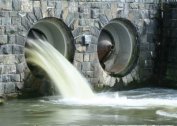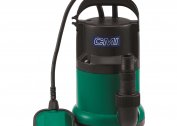The choice of a local sewage treatment device involves taking into account such factors as the topography of the territory, features of the soil and climate, the number of residents and the amount of water consumed. Important design characteristics and functionality of the treatment plant. Given these factors, as well as reviews of autonomous sewers of owners of private houses, you can choose an economical and effective option.
Types of autonomous sewers for a private house
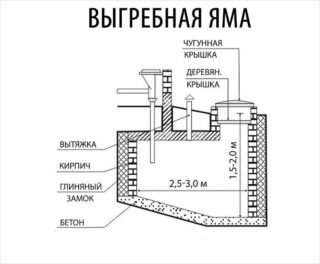 Information on the principle of operation of the main types of structures and their purpose will help determine the type of structure.
Information on the principle of operation of the main types of structures and their purpose will help determine the type of structure.
Cesspools
These are the simplest sewer devices. They are mounted with your own hands as follows:
- Sealed tanks made of plastic or concrete rings are deepened into the ground. Sometimes the foundation pit is laid out with bricks, followed by sealing.
- A pipeline with a section of 110 mm is drawn from the internal sewage of the building to the tank under a small slope in the direction of the drain. The depth of its laying should be below the level of freezing of the soil.
- When the pit is filled by 75 percent, they call on specialization equipment for collecting sewage.
The frequency of wastewater pumping depends on the speed of filling the pit. Between the surface of the soil and water should not be less than 35 cm, so that sewage does not infect the fruiting layer.
Among the design advantages are environmental safety with timely pumping, ease of installation and budget price. The device is non-volatile. But drains from the pit must be regularly pumped out. If ground sources pass high, the construction is inefficient. It is better to equip cesspools in cottages or in small private houses with a small number of residents.
Septic devices
Septic tanks are used for wastewater treatment. They consist of one, two or three chambers, complemented by a filtration well, infiltrator and aerator. Structures are made of durable polymers or concrete rings.
All VOC tanks go deep into the soil and are connected by communication lines above the level of soil sources.
The difference from the cesspool is that autonomous septic devices not only accumulate wastewater, but also lighten them with filters and anaerobic bacteria. In the first chamber there is sedimentation of sludge, in the subsequent - further purification of the liquid.
The advantages of septic tanks in their non-volatility and the ability to use clarified water for technical needs.
Periodically, the tanks must be cleaned and replenished with the number of beneficial microorganisms. Select a septic sewerage for a country house in cases where residents are there year-round.
Single chamber septic tanks are undesirable to be placed on clay soils or in areas with a high location of underground sources. In these cases, a three-chamber treatment plant with a biofilter is purchased.
Bio-treatment systems
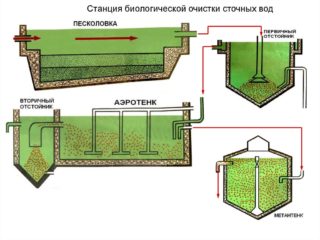 Such a device is characterized by maximum efficiency, but it is expensive and requires electricity. The deep biological treatment station includes:
Such a device is characterized by maximum efficiency, but it is expensive and requires electricity. The deep biological treatment station includes:
- receiving chamber;
- aeration tank;
- secondary sump;
- active sludge stabilizer.
In the receiving chamber, heavy suspensions settle to the bottom, fat particles are separated. Further, the liquid undergoes double purification by microorganisms, the activity of which is constantly stimulated by the supply of oxygen. At the outlet after filtration, almost pure water is obtained. It is not worth drinking it, but it is quite suitable for watering the garden.
Install similar systems in areas with any soil.Pumping of wastewater is not required here, only a routine inspection and the addition of cleaning bacteria. They are added through the drain holes of plumbing fixtures.
It is an environmentally friendly device that does not emit any odors. It is suitable for large cottages with permanent residence, since one station is able to process up to one and a half cubes per day.
General selection criteria
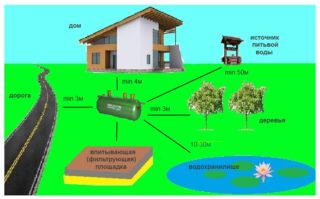 The selection of a cleaning system must be approached carefully. Even a well-publicized device will not work efficiently if performance is not met. In the worst case, the case of the device will crack, and sewage will fall into the soil. This threatens environmental contamination, there is a risk of harm to the health of the residents of the house.
The selection of a cleaning system must be approached carefully. Even a well-publicized device will not work efficiently if performance is not met. In the worst case, the case of the device will crack, and sewage will fall into the soil. This threatens environmental contamination, there is a risk of harm to the health of the residents of the house.
To avoid an emergency, the following indicators must be taken into account:
- Distance to nearby communications and buildings. The distance from the treatment plant to water supply points or buildings should not be less than 10 m, to the garden and garden - meter.
- Soil composition and groundwater level. This factor is important for cesspools and septic tanks. If the groundwater is high, such facilities will not work.
- The number of residents, the amount of water consumed and the "volley discharge". It is higher if there is a lot of plumbing in the house - the water flows in a big stream. In this case, you need a powerful cleaning device with multiple cameras.
- Uninterruptible power supply. If electricity is not supplied to the house, only non-volatile structures can be installed.
All sewer devices have their advantages and disadvantages, they are designed for different income levels of owners, area and hydrogeological features of the territory. Manufacturers offer ready-made devices, the installation of which requires a minimum of time and cost. If there is no desire or ability to use a cesspool, it is worth choosing one of the types of septic tanks.
Consumer Reviews
 Owners of private houses on specialized sites share their impressions of the work of cleaning devices. The following models have good recommendations:
Owners of private houses on specialized sites share their impressions of the work of cleaning devices. The following models have good recommendations:
- Topop 8 of the Eco-Grant brand. Users note that the station works completely silently, even with the hatch open, only a slight gurgling is heard. There is a slight smell only in the first month of work, when the bacteria still take root. In the cold and in the heat does not lose functionality. Does not float even with high groundwater.
- Genezis brand Deca. The device is controlled using the GSM module. In an emergency, it will call the masters to the house, but such situations, according to users, are extremely rare. Compared to other devices, it does not give off a smell at all.
- "Astra 5" brand "Unilos". The cleaning station, according to users, works like a clock. They note the efficiency of the device with high functionality.
Based on the reviews, ratings of the most popular and effective devices are created. According to their data, you can choose a suitable system among peers in terms of technical characteristics.
Rating of autonomous sewers for a country house:
| A place | Model | Distinctive features |
| Inexpensive non-volatile septic tanks | ||
| 1 | Rostock Mini | Work stability. |
| 2 | "Termite Profi 1.2" | The increased durability. |
| 3 | Tank 1 | Budget cost with good performance. |
| Biological treatment systems | ||
| 1 | Topas 8 | Profitability and efficiency. |
| 2 | "Poplar" | Favorable price / quality ratio. |
| 3 | Astra 5 | Work stability. |
All these data are indicative. The best autonomous sewage system is selected depending on the individual installation conditions.
You can do the installation of a simple treatment plant yourself, but technically sophisticated devices with power supply will require the involvement of professionals. Do not risk the expensive device and the health of loved ones.

